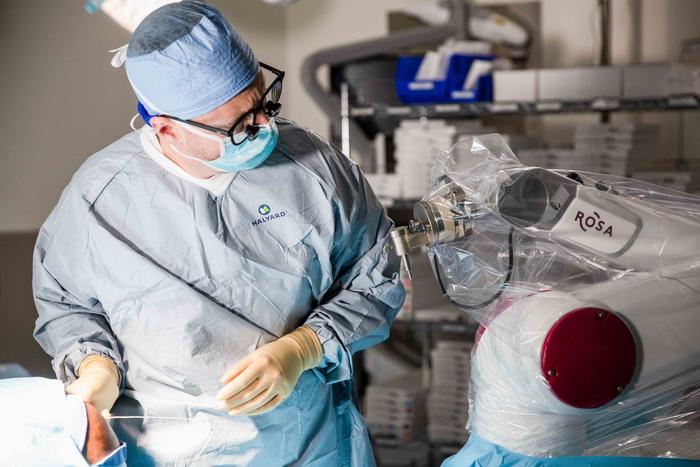The results of a human study carried out by an international research team have provided valuable new insights into the activity of the brain’s noradrenaline (NA) system, which has been a longtime target for medications to treat attention-deficit/hyperactivity disorder, depression, and anxiety. The study employed what the researchers claim is a groundbreaking methodology, developed to record real-time chemical activity from standard clinical electrodes implanted into the brain routinely for epilepsy monitoring.
The results offer up new insights into brain chemistry, which could have implications for a wide array of medical conditions, and also demonstrate use of the new strategy for acquiring data from the living human brain.
“Our group is describing the first ‘fast’ neurochemistry recorded by voltammetry from conscious humans,” said Read Montague, PhD, the VTC Vernon Mountcastle research professor at Virginia Tech, and director of the Center for Human Neuroscience Research and the Human Neuroimaging Laboratory of the Fralin Biomedical Research Institute at VTC. “This is a big step forward and the methodological approach was implemented completely in humans – after more than 11 years of extensive development.” Montague is senior, and co-corresponding author of the researchers’ published paper in Current Biology, which is titled “Noradrenaline tracks emotional modulation of attention in human amygdala.” In their paper the authors concluded, “By showing that neuromodulator estimates can be obtained from depth electrodes already in standard clinical use in the conscious human brain, our study opens the door to a new area of research on the neuromodulatory basis of human health and disease.”
The noradrenaline system is one of the brain’s major neuromodulatory system, the authors noted. Originating in a small midbrain nucleus, the locus coeruleus (LC), the NA system projects widely throughout the brain. However, the researchers noted, “… our understanding of its role in health and disease has been impeded by a lack of direct recordings in humans.”
Voltammetry techniques for making real-time electrochemical readings in rodents and other laboratory models have yielded deep insights into brain function for about 30 years, but there has been no clear path to use the techniques in humans, because they require electrodes to be inserted into the brain.
The researchers have focused on applying technology that’s already being used in patients for medical procedures, explained Montague, who is also a professor in the Department of Physics at the Virginia Tech College of Science and in the Department of Psychiatry and Behavioral Medicine at the Virginia Tech Carilion School of Medicine. “When are surgeons already putting a wire in someone’s brain? And could we design a method to piggyback on that?”
The team’s initial approaches required the insertion of exclusive carbon-fiber electrodes, designed at the Fralin Biomedical Research Institute, into awake patients receiving deep brain stimulation (DBS) surgery for Parkinson’s disease or other disorders.
In what they call a groundbreaking 2011 study the group was the first to observe sub-second variations in brain chemicals in awake human subjects. The scientists later discovered how dopamine and serotonin jointly underpin human decision-making and sensory processing in a series of publications in 2016, 2018, and 2020 by using these specially designed electrodes inserted during deep brain stimulation surgery.
However, the team explained in their paper, the use of such technology has “… naturally been constrained to the basal ganglia, mainly dorsal striatum, by the surgical procedures.” They pointed out, “ … an accurate understanding of neuromodulatory systems in human health and disease will require an ability to study their function across the brain, especially in the case of the locus coeruleus (LC)-noradrenaline (NA) system, which plays a minimal role in the regulation of striatal activity.”

The authors added, “Clinically, the LC-NA system is implicated in multiple conditions, perhaps most prominently attention deficit/hyperactivity disorder. Yet there has not been a way to directly measure NA in humans.”
Patients with medication-resistant epilepsy can become eligible for ablation of epileptic foci. To help localise these foci, the individual receives an implant of depth electrodes in the brain region relevant to their condition. Neuronal activity is then tracked over a number of days in the epilepsy monitoring unit (EMU).
The study by Montague and colleagues aimed to try and shed some light on how he NA system responds to various emotional states. To do this, three individuals with the epilepsy monitoring electrode implants performed a visual affective oddball task. They viewed neutral, checkerboard images mixed with emotionally charged images from the International Affective Pictures Database. “The task was designed to induce different cognitive states, with the oddball stimuli involving emotionally evocative images, which varied in terms of arousal (low versus high) and valence (negative versus positive),” the investigators explained. And in parallel with the electrochemical recordings, the scientists monitored pupil dilation, “a widely used behavioral proxy for activity in the LC-NA system,” they pointed out.
As expected, the results showed that NA levels correlated with emotional intensity, particularly during encounters with unexpected images, underscoring the NA system’s significance in conditions like ADHD. “Here, we provide proof of concept that electrochemical recordings of sub-second NA dynamics can be made using clinical depth electrodes implanted for epilepsy monitoring,” they commented. “For years neuroscientists have utilized these electrodes for intracranial electrophysiology—we show that they can be used for intracranial electrochemistry, too.”
The capacity to perform human electrochemistry in the epilepsy monitoring unit also complements the DBS-based approach in multiple ways, the team pointed out. “It enables electrochemical recordings from a wider range of neural structures, and it allows for the study of physiological, behavioral, and cognitive processes that cannot be probed in within the constraints of an acute surgical setting.” Giving examples, the scientists pointed out that the LC-NA system is a pharmacological target in sleep disorders, and using their approach will make it possible to monitor NA as patients transition between wakefulness and sleep. “Similarly, a proportion of patients will be undergoing pharmacotherapy, such as selective serotonin reuptake inhibitors (SSRIs) or serotonin-NA reuptake inhibitors (SNRIs), for psychiatric symptoms, and it will be possible to compare neuromodulation before and after drug intake,” they stated.
“This is groundbreaking work that represents a significant technical advance in our ability to understand human brain activity,” said Wael Asaad, director of Functional and Epilepsy Neurosurgery at Rhode Island Hospital and vice chair for research in the Department of Neurosurgery at Brown University, who was not involved in the research. “While it has been possible to record electrical brain activity in humans in a variety of settings for many years, this gives us only half the picture. How those neurons communicate with neurotransmitters in real-time, at short-timescales, has generally been much more difficult to study. In addition to the scientific value of this study, the techniques it demonstrates will be of tremendous value for a broad range of studies. It represents a milestone in our efforts to understand the functions of human brain circuits.”



